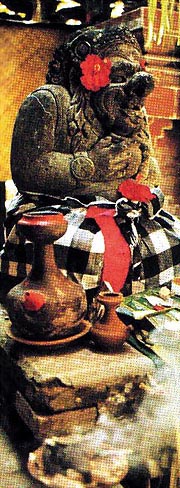by Chalerm Raksanti
Bali hangs like a glowing emerald in the necklace of
the Indonesian archipelago. Lava-flanked peaks, two of them active, roof
the islandís ninety mile length. Streams tilt down slopes shingled with
fertile rice paddies. Though Java lays only a mile away, fierce currents
and reefs long isolated Bali. This isolation favored the development of
its distinct culture.
 Preparation
for tooth filing ceremony
Preparation
for tooth filing ceremony
Spiritual values are the strongest motivating force of
life on the island, and prompt the exuberant festivities which punctuate
most of Balinese life. Their religion is a complex and imaginative blend
of Hinduism, animism and ancestor worship. Hinduismís deepest inroads
into Baliís animism came in the 16th century, after the armies of Islam
had defeated the powerful Madjapahit Hindu dynasty. In East Java the weak
Hindu princes capitulated, but the undaunted fled across the mile-wide
strait to Bali, accompanied by musicians, poets, dancers and artists.
Within a century, Dutch explorers, lured to the East
Indies by spices, built a commercial empire in Indonesia. Baliís
treacherous reefs and unpredictable currents caused these voyagers to sail
on safer shores. Thus insulated, the seeds of Javaís transplanted Hindu
culture took root and flourished for almost 400 years in Bali under the
refugee princes who carved up the island into tiny kingdoms. The Balinese
culture endured a history fraught with turbulence and violence. It has
weathered a Dutch domination, Japanese occupation during WWII, the war of
Indonesian independence, and the bloody foiling of a Communist coup
attempt.
 Deity
dressed for a part
Deity
dressed for a part
Today Bali faces the invasion of tourists; what the
Balinese call the Ďjet invasioní. But for the romantic sojourner, it
is still possible to seek out Baliís special moments. Paradise (like the
visions or dreams which inspire us to create such a concept) lies in the
eye and the mind of the beholder. More than just a place, Bali is an
impression, a feeling and an experience. Roaming through Baliís
rice-rich heartland, the visitor can trek through wild scrub jungle in the
west, up to the limestone cliffs at the southern tip of the island, and to
northern plantations of coffee and coconut. And along the back roads of
this tropical jewel, the Balinese will welcome you. But whatever they are
doing, they do for themselves, and not for your entertainment.
One ancient custom which is still practiced in the
villages is the tooth filing ceremony. The joyous ritual, performed for
both sexes, protects against the evil in human nature. This is a ceremony
which marks the coming of age for pubescent youngsters. A priest rubs a
gold ring on the boy or girlís mouth, and then he wields his tapered
file until he grinds down the six upper front teeth until they are all
even. The event is nerve wracking, but almost painless.
Balinese life is influenced by innumerable gods and a
rich tapestry of occult and the mysterious world of the unseen. Many of
their festivals are extravaganzas for the gods. Women of Tulikup, a
village near the southeast coast, thread their way through a palm-ached
pathway bearing offerings of good and flowers on a three mile march to the
sea. Behind them, a snake-like column that stretches across a mile of rice
paddies, men bring images of deities from the village temple for an annual
cleansing in the Indian Ocean. This done, the islanders will joyously
feast on the offerings of duck, rice and fruit.
 Trance
dancers
Trance
dancers
Young girls from the village of Kintamani, in the
shadow of the smoldering volcano Batur, perform the sanghyang deling, a
trance dance. This is one of the rituals that dramatize the villagersí
constant awareness of the supernatural world. As a chorus chants to a
flute and drum, older women choose certain girls whom they believe are
particularly receptive to the influence of the gods. A mystic priest
prepares a brazier of burning incense, and puppet masters manipulate two
sacred puppets, making them dance. Soon the girls are transfixed and grow
drowsy. Their eyelids droop and they slide forward and, at last, deep in a
trance, they begin a dreamlike dance, gliding and twirling, oblivious to
everything around them. They shuffle barefoot through a bed of smoldering
coconut shells. Then the priest frees, unhurt, from the spell.
It takes only a brief encounter with the menacing surf
gnawing at Baliís coastline to understand why the Balinese regard the
sea as the domain of their demons, and why their gods choose to dwell in
the mountains. Of course demons pose no threat to tourists who flock to
the beaches in droves. But most tourists only travel paved roads, which
bypass the small villages to avoid overwhelming the quiet local life.
Balinese culture is stronger than the tourist.
![]()
 Preparation
for tooth filing ceremony
Preparation
for tooth filing ceremony Deity
dressed for a part
Deity
dressed for a part Trance
dancers
Trance
dancers